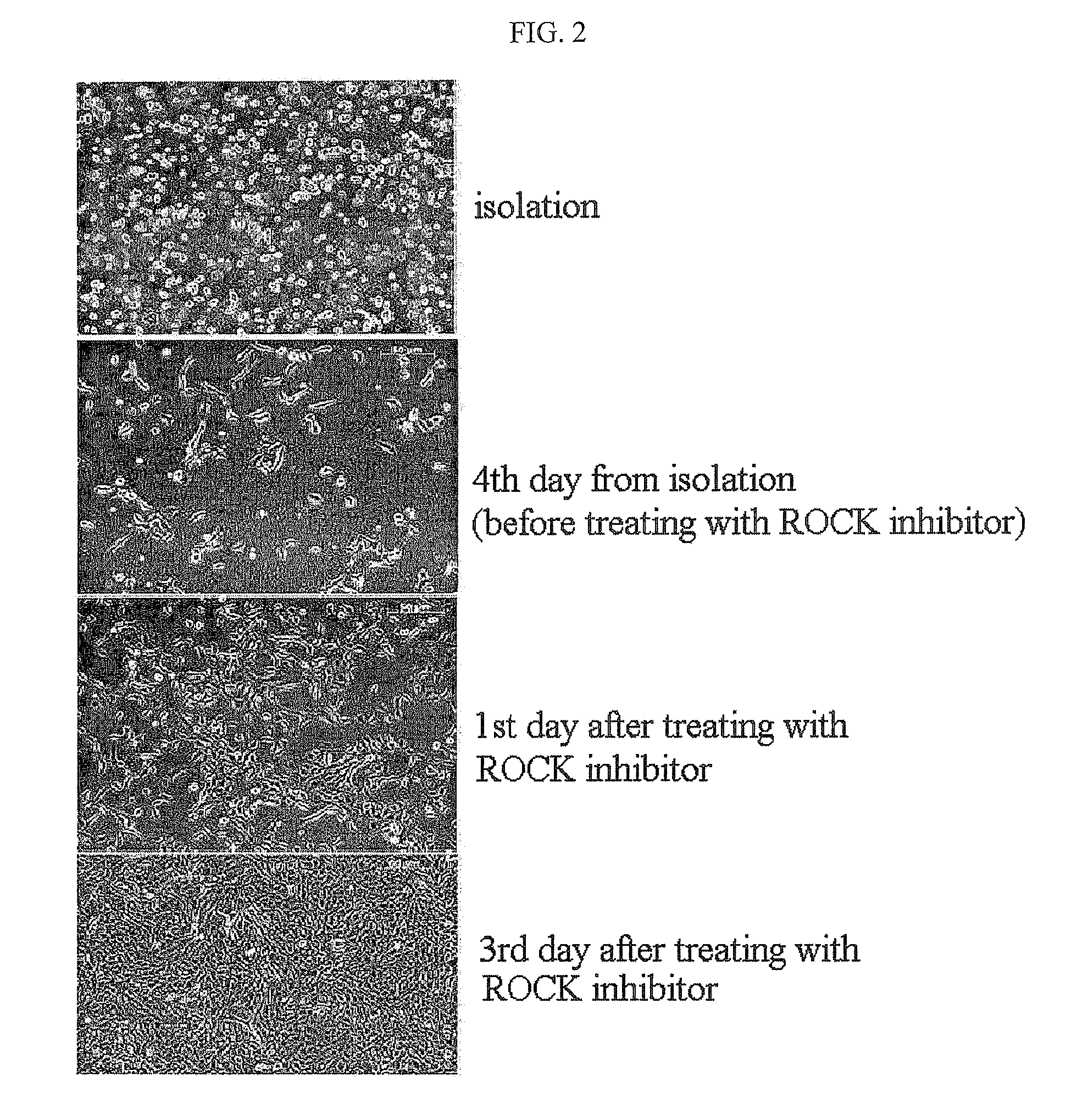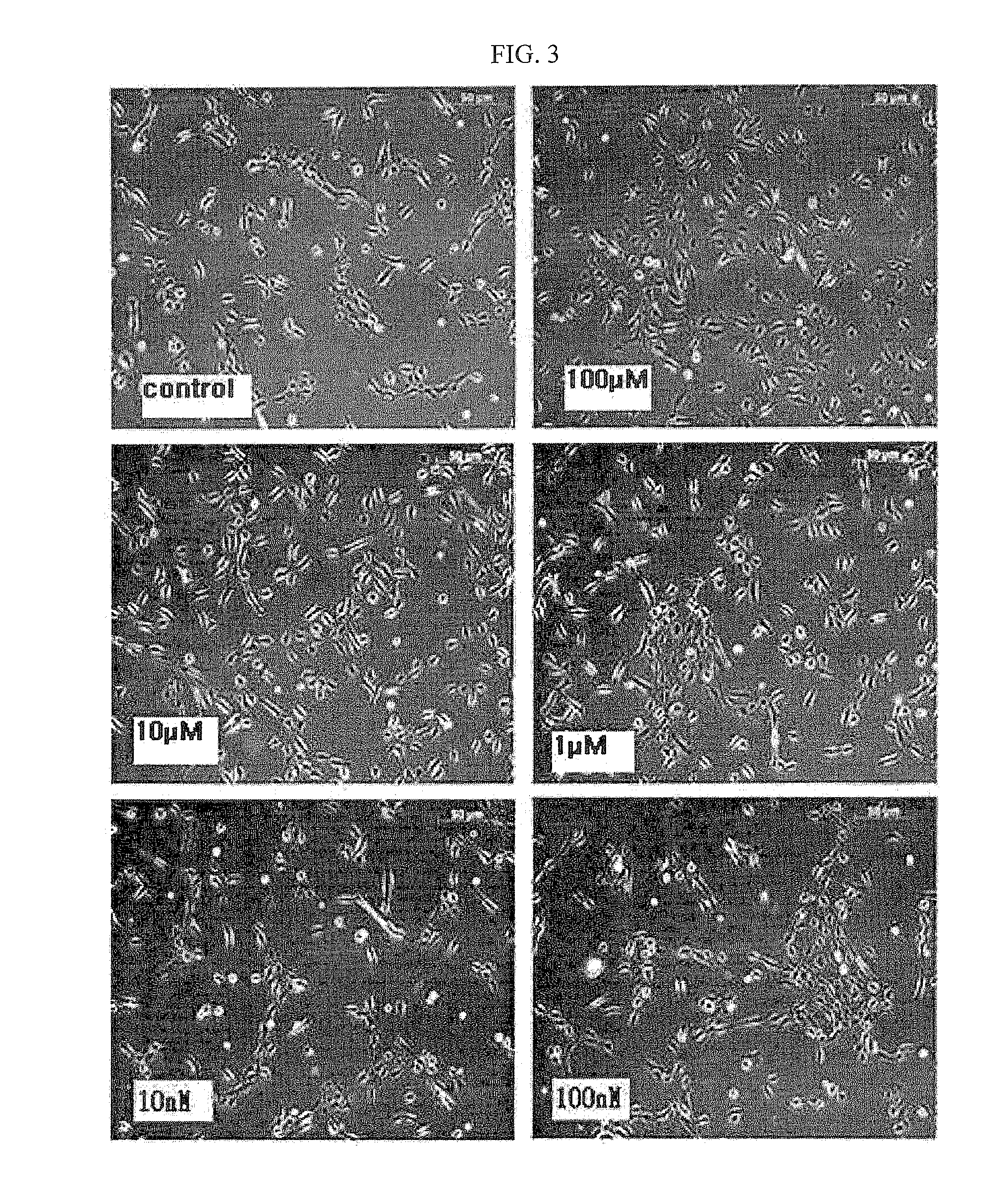Method for isolating and culturing adult stem cells derived from human amniotic epithelium
a technology of amniotic epithelium and stem cells, which is applied in the direction of artificial cell constructs, biocide, drug compositions, etc., can solve the problems of difficult culture, inability to achieve efficient use of amniotic stem cells, and difficulty in maintaining isolated stem cells in vitro, and achieves high yield
- Summary
- Abstract
- Description
- Claims
- Application Information
AI Technical Summary
Benefits of technology
Problems solved by technology
Method used
Image
Examples
example 1
Isolation of Amniotic Epithelial Cells from Amniotic Tissue by Treatment with DTT (Dithiothreitol) and Trypsin
[0082]Amniotic membranes were collected at normal births and premature births in Korea University Guro Hospital according to the Institutional Review Board Guidelines of Korea University and used for research purposes. Amniotic tissue required in experiments was isolated from the placenta, and the isolated tissue was stored in an antibiotic-containing physiological saline or DMEM medium.
[0083]5 g of amniotic tissue was weighed and washed with HBSS. For stable isolation of amniotic epithelial cells, the washing process was carried out using HBSS buffer more similar to the constituents of the human body rather than using general PBS. The washed amniotic tissue was transferred into a 50-ml tube, and 10 mM DTT was added thereto. After treatment with DTT for 30 minutes, the supernatant was discarded, the amniotic tissue was finely cut, and the finely cut amniotic tissue was treat...
example 2
Culture of Amniotic Epithelial Cells in the Presence of ROCK Inhibitor
2-1: Culture of Amniotic Epithelial Cells
[0087]The obtained amniotic epithelial cells were cultured in a medium (Gibco) consisting of a 1:1 mixture of DMEM (Dulbecco modified Eagle medium) and F-12 (nutrient mixture) to which FBS, ascorbic acid, epidermal growth factor, insulin, an antibiotic and 10 μM of ROCK inhibitor Y-27632 have been added at the concentrations shown in Table 2 below.
[0088]
TABLE 2ComponentConcentrationComponentConcentrationBasal MediaDMEM / F-12 1:1Insulin5 ug / mlmixtureFBS10% (v / v)Ascorbic acid0.2 mMEGF20 ng / mlAntibiotic-antimycotic1 X
[0089]After 3 days of culture, the adult stem cells derived from the cultured amniotic epithelial cells were washed with HBSS buffer, and then incubated with Tryple-express (Gibco) or 0.25% trypsin-EDTA at 37° C. for 10 minutes. An FBS-containing medium was added thereto to inactivate trypsin, and then 5×106 stem cells derived from the amniotic epithelial cells wer...
example 3
Comparison of the Abilities of Stem Cells to Proliferate according to ROCK Inhibitor Treatment Period
[0096]In order to further improve the proliferation ability of the amniotic epithelial cells obtained in Example 1, the method used in the embryonic stem cell study (Watanabe et al., Nature Biotechnology, 25:681, 2007) and the method of adding ROCK inhibitor during the culture were compared. In other words, the culture in which 10 μM of ROCK inhibitor was added only before reseeding was compared with the culture in which the ROCK inhibitor was added even after reseeding.
[0097]As a result, as can be seen in FIG. 6, in the case (A) of treatment with the ROCK inhibitor only before reseeding, the proliferation ability of the adult stem cells derived from the amniotic epithelial cells was clearly increased compared to the control without ROCK inhibitor treatment. Meanwhile, in the case (B) in which the ROCK inhibitor was continuously added during the reseeding and culture procedure, the p...
PUM
| Property | Measurement | Unit |
|---|---|---|
| size | aaaaa | aaaaa |
| diameter | aaaaa | aaaaa |
| concentration | aaaaa | aaaaa |
Abstract
Description
Claims
Application Information
 Login to View More
Login to View More - R&D
- Intellectual Property
- Life Sciences
- Materials
- Tech Scout
- Unparalleled Data Quality
- Higher Quality Content
- 60% Fewer Hallucinations
Browse by: Latest US Patents, China's latest patents, Technical Efficacy Thesaurus, Application Domain, Technology Topic, Popular Technical Reports.
© 2025 PatSnap. All rights reserved.Legal|Privacy policy|Modern Slavery Act Transparency Statement|Sitemap|About US| Contact US: help@patsnap.com



